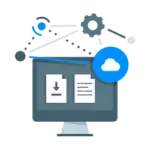Not only do computer viruses pose a major risk to personal and company data security, but they also threaten departmental operations. These viruses spread through different pathways, each carrying varying levels of risk and requiring different protection methods. While many of us are familiar with traditional virus transmission methods like email attachments, boot infections, and program infectors, viruses can also spread through some less obvious, traditional methods. Knowing these techniques can help safeguard your computer against infections.
Infection by Removable Disks (Floppy, Zip, CDs, etc.)
Floppy disks, though nearly obsolete today, were once a major avenue for virus spread. When a virus copies itself to a floppy disk, any file taken from an infected computer could contain the virus, quickly compromising other computers. If that floppy disk is used on another computer, it could easily infect the new system or recontaminate an old one. A normal “format disk” in Windows™ often isn’t enough to clean an infected floppy, requiring a low-level format.
CDs present an even greater risk. Once a CD is infected, it cannot be cleaned. The only solution is to dispose of the infected CD to prevent further cross-infection.
Infection from Networks
Networks, including Peer-to-Peer (P2P) networks, Local Area Networks (LAN), Wide Area Networks (WAN), wireless networks, and the Internet, enable the sharing of software and data resources among computers. This same ease of sharing also makes networks a prime mode for virus transmission.
Viruses, worms, and Trojans often spread through shared files. The increased competition in the digital space has led to the rise of automatic mass mailing attacks and system resource attacks. Some attacks specifically target large commercial entities like Microsoft, eBay, Amazon, and major banks to disrupt their online services in what is known as a Denial of Service (DOS) attack.

In these cases, your computer may be hijacked without your knowledge and used in an attack. Keeping your computer protected with active virus and firewall software can prevent it from being used in such attacks.
Other Ways Viruses Spread
Beyond removable disks and networks, viruses can enter your system through other means. The Internet is a major culprit, as nearly everyone downloads apps from the web. While software patches, drivers, and demo programs from reputable companies pose little risk, “unofficial” software applications or low-budget packages picked up from questionable sources may be virus-infected either accidentally or intentionally.
It’s often found that computer viruses spread more rapidly from files downloaded directly from the Internet through file-sharing programs, executable files, or ActiveX controls than through email. These viruses spread quickly, often evading security software due to smart programming and widespread use.
Email and Instant Messaging Systems
Email and instant messaging systems, while making communication easier, have also made it easier to transmit viruses. These systems are accessible to almost anyone and are widely used globally, making them easy targets for virus creators. Most new viruses and Internet worms are designed to exploit the default settings in popular email clients like Outlook and Outlook Express or instant messaging systems.
For email or instant messaging systems that come built-in with your computer’s operating system, keeping updated real-time scanning patterns is crucial. Additionally, learning how to disable default actions that leave your system vulnerable is important.
The Importance of Antivirus Protection
With viruses able to spread via disks, local area networks, and the Internet, comprehensive antivirus protection is essential. Antivirus software is your first line of defense against these threats and must be kept constantly updated. Staying on top of virus protection ensures your antivirus software can identify and thwart the latest threats.
It’s crucial to avoid downloading software from unknown and untrustworthy sources and to be cautious when using removable disks that have been used on other computers.
Protecting Your System
This two-fold testing approach will protect your device from viruses. For example, clicking on unknown or random links in emails is one of the worst mistakes people make regarding computer security. By understanding how viruses spread, you’ll know what to do to protect your computer and personal information.
Conclusion
Predicting how new viruses will evolve and spread in the future is impossible. However, staying informed about the latest transmission methods and taking protective steps can minimize these risks. Always run current antivirus software, be cautious with downloads, email attachments, and check for necessary patches. This way, you’ll be able to prevent viruses from corrupting your computer and data.



